Misc Dolphin photos: Difference between revisions
Pbcjohnston (talk | contribs) (Formatted page) |
Pbcjohnston (talk | contribs) mNo edit summary |
||
| (12 intermediate revisions by 2 users not shown) | |||
| Line 1: | Line 1: | ||
[[File:Header | [[File:Header 169.jpg]] | ||
[[File:D-1 Construction TR-a.jpg|left|500px]] | |||
[[File]] | <div style="text-align: justify;"><span style="color:#00008B">This is the Dolphin's forward Torpedo Room under construction at the Portsmouth Navy Yard in Kittery, ME., mid 1931. At the forward end of the compartment are the openings for four of her six torpedo tubes (the other two are in the stern). The tubes themselves have not yet been installed. Views of the shipyard are visible through the openings. | ||
<div style="text-align: justify;"><span style="color:#00008B"> | |||
It is noted by the light seen between the frames that the hull plating has yet to be completed. | |||
Dolphin has been reported in several authoritative history texts has having been of fully riveted construction. Yet, in the lower left-hand corner of this photo welding beads can be seen where the I-beam frames meet the deck (actually the top of the forward trim tank). There is also a line of rivets running port to starboard along the top of the deck. | |||
This photo, along with other photos on the Dolphin exterior pages are proof positive that this boat was built to a partial-riveted/partial welded construction method, over a year prior to the start of construction of the [[171|'''USS Cuttlefish (SS-171)''']] at Electric Boat. The Cuttlefish is incorrectly believed to be the first welded submarine by most historians. | |||
<small>US Navy photo contributed by Tracy White</small> | |||
[[File:Red bar sub new.jpg]] | |||
[[File:D-1 Construction TR-b.jpg|left|500px]] | |||
<div style="text-align: justify;"><span style="color:#00008B">This is the Dolphin's forward torpedo room just shy of 13 months later, still under construction. At the forward end of the compartment the four torpedo tubes have been installed and mostly plumbed. Equipment is being installed and the room is nearing completion. The large brackets installed on the frames are to hold the Mk 14 torpedo weighing 3300 pounds. Dolphin was designed to carry 18 of these weapons. | |||
Dolphin's forward escape trunk can be seen above where the planks cross. The angled ladder leading to the trunk is seen leading into the trunk. In the upper left a large rod is seen. This is the mechanical linkage for the bow planes that runs back to the control wheel in the control room. | |||
<small>US Navy photo contributed by Tracy White</small> | |||
[[File:Red bar sub new.jpg]] | |||
[[File:gen room-c.jpg|left|500px]] | |||
<div style="text-align: justify;"><span style="color:#00008B">This is the Dolphin's generator room, the next compartment aft of the after battery. The starboard generator engine has been installed and the view is looking forward. The forward walking deck has not been completed and the sheet metal sides of the mezzanine level storerooms around the galley and Chief's Mess area can be seen. | |||
One more engine will be installed, and this will be lowered into the space via an opening in the hull above the wood ladder. Engineering spaces had what is called a "soft patch" in the hull that was bolted to the pressure hull to allow large pieces of equipment to be removed, repaired or replaced without needless cutting into the hull. | |||
These engines were installed "backwards" in the space, with the generator attached to the crankshaft on the forward end of the engine; the generator itself is in the space underneath the storerooms and galley. The storerooms and galley are technically in the Generator Room and not the traditional position in the after battery. The amount of work left to complete in this space is considerable; compare this photo with similar photos on the [[Dolphin Generator Room|'''interior photos page''']] of the completed space. | |||
<small>US Navy photo contributed by Tracy White</small> | |||
[[File:Red bar sub new.jpg]] | |||
[[File:dolphin-ext-001.jpg|left|500px]] | |||
<div style="text-align: justify;"><span style="color:#00008B">Dolphin just beginning her slide down the ways at Portsmouth Navy Yard on March 8, 1932. Her hull superstructure is only completed from the bow to about the conning tower area. | |||
There are smatterings of Navy crew in amongst the shipyard worker riding the submarine down the ways. At the bow the Portsmouth Navy Yard Banner is flying. It reads backwards because the back of the banner is only seen by the camera. You may notice that in subsequent photos that there are anchors on both bows. This was later reduced to only one anchor per submarine. | |||
There seems to be a distinct lack of bunting and ceremony involved in this launch. Perhaps due it being several years into the Great Depression and the government needed to show signs of austerity. | |||
<small>U.S. Navy photo</small> | |||
[[File:Red bar sub new.jpg]] | |||
[[File:dolphin-ext-002.jpg|left|500px]] | |||
<div style="text-align: justify;"><span style="color:#00008B">The newly launched Dolphin floating free of her builder's cradle at Portsmouth Navy Yard March 8, 1932. The incomplete state of her superstructure aft of the conning tower is evident. The large "barrels" on her aft deck are the huge mufflers for her main diesel engines. Not yet installed is the after escape trunk. It is a brisk, windy day! This primitive state of completion upon launch was not typical of the Navy yards at the time. Usually the boats were 65% plus complete at launching. Why the Dolphin was launched in this state is not known. | |||
<small>U.S. Navy photo in the private collection of Ric Hedman</small> | |||
[[File:Red bar sub new.jpg]] | |||
[[File:dolphin-ext-003.jpg|left|500px]] | |||
<div style="text-align: justify;"><span style="color:#00008B">A close up of the photo above, showing details of the conning tower and the fairwater framing. | |||
<small>U.S. Navy photo in the private collection of Ric Hedman</small> | |||
[[File:Red bar sub new.jpg]] | |||
[[File:dolphin-ext-004.jpg|left|500px]] | |||
<div style="text-align: justify;"><span style="color:#00008B">The newly launched Dolphin being warped to the pier by a tug at Portsmouth Navy Yard, March 6, 1932. | |||
<small>U.S. Navy photo</small> | |||
[[File:Red bar sub new.jpg]] | |||
[[File:dolphin-ext-005.jpg|left|500px]] | |||
<div style="text-align: justify;"><span style="color:#00008B">Launch crew pose for photos after the Dolphin has been warped to the pier following her launching, March 6, 1932. | |||
The officers seen here are from left to right: Executive Officer, LT Robert Eugene Blue; Commanding Officer, LT John B. Griggs Jr.; LTjg David E. Roth, and Ensign J. B. Johnson. The place the men are standing is sloped up to the right so that is why the photo looks strange. The cameraman "leveled" the picture to the deck. | |||
<small>U.S. Navy photo in the private collection of Ric Hedman</small> | |||
[[File:Red bar sub new.jpg]] | |||
[[File:dolphin-ext-037.jpg|left|500px]] | |||
<div style="text-align: justify;"><span style="color:#00008B">Dolphin (SS-169) and Bonita (SS-165) at Balboa, Panama Canal, 1934. The presence of the newly installed side steps for small boat boarding firmly dates this photo after her 1933 West Coast return to her new home port of San Diego, CA. | |||
<small>US Navy Photo Contributed by Roger Torgeson</small> | |||
[[File:Red bar sub new.jpg]] | |||
[[File:dolphin-ext-038.jpg|left|500px]] | |||
<div style="text-align: justify;"><span style="color:#00008B">Dolphin off an unidentified shoreline, probably in 1934-1935. We have seen other copies of this photo describing it as in Hawaii circa 1940 but that is not a Hawaiian coastline. With the presence of the accommodation ladder seen in this photo this has to have been taken after her August 1933 return to the west coast. The shoreline looks to be more of a California coast than a New England Shore or Hawaii. | |||
The sub has D-1 on her conning tower and bow. By March of 1939 that had been removed in favor of her hull number, plus she had been painted black as were most of the west coast submarines starting in 1934. She was used in the movie "Submarine D-1" in 1937 and had been painted black by that time. | |||
Also, the crew are in Blue uniforms. These are worn from September 1 to May 31 in temperate climates. Hawaii is in the tropics and whites are worn all the time. | |||
The submarine seems to be preparing to moor up to another vessel. The man all the way forward is getting ready to raise the Union Jack and the man all the way aft is ready to raise the American Flag. The underway colors are flying from the aft end of the conning tower fairwater. The man just left of the man at the bow is standing by with a heevie (a weighted line for tossing) to toss to the ship to haul the mooring lines across. Line handlers are standing by along the submarine's deck. | |||
<small>US Navy Photo Contributed by Roger Torgeson</small> | |||
[[File:Red bar sub new.jpg]] | |||
[[File:dolphin-ext-039.jpg|left|500px]] | |||
<div style="text-align: justify;"><span style="color:#00008B">The Dolphin at gunnery practice circa 1937. The Navy began a fleet wide change to the submarine paint scheme starting in 1935-1936. A series of tests in Hawaiian waters showed that a simple flat black worked the best so the new color was mandated for the entire force, ending the run of the traditional haze gray. This color scheme is still in effect to the modern day. The gun crew has just fired a round and the smoke from that can be seen at the left, in front of the submarines bow. The gun crew is busy loading another round for the next shot. The Dolphin carried a 4"/50 caliber gun as her main gun armament. | |||
Just below the cluster of men manning the deck gun you can see the port side accommodation ladder. | |||
<small>News Photo Contributed by Roger Torgeson</small> | |||
[[File:Red bar sub new.jpg]] | |||
[[File:dolphin-ext-039a.jpg|left|500px]] | |||
<div style="text-align: justify;"><span style="color:#00008B">A close up of the photo above, with a sepia tone to bring out details. The gun crew has just fired a round and the smoke from that can be seen at the left. The crew is busy loading another round for the next shot. The round was passed by hand from crewman to crewman from the magazine below the control room up through the conning tower and then to the men on deck. | |||
<small>Photo in the private collection of Ric Hedman</small> | |||
[[File:Red bar sub new.jpg]] | |||
[[File:dolphin-ext-040.jpg|left|500px]] | |||
<div style="text-align: justify;"><span style="color:#00008B">The Dolphin, again circa 1937, seen in San Diego Harbor some time prior to her departure for Hawaii on December 1, 1937. | |||
<small>U.S. Navy photo</small> | |||
[[File:Red bar sub new.jpg]] | |||
<center>[[Dolphin|Return to Dolphin main page]] | [[V-class|Return to V-class main page]]</center> | |||
[[File:Red bar sub new.jpg]] | [[File:Red bar sub new.jpg]] | ||
<center> | <center> | ||
Latest revision as of 21:40, 7 December 2023

It is noted by the light seen between the frames that the hull plating has yet to be completed.
Dolphin has been reported in several authoritative history texts has having been of fully riveted construction. Yet, in the lower left-hand corner of this photo welding beads can be seen where the I-beam frames meet the deck (actually the top of the forward trim tank). There is also a line of rivets running port to starboard along the top of the deck.
This photo, along with other photos on the Dolphin exterior pages are proof positive that this boat was built to a partial-riveted/partial welded construction method, over a year prior to the start of construction of the USS Cuttlefish (SS-171) at Electric Boat. The Cuttlefish is incorrectly believed to be the first welded submarine by most historians.
US Navy photo contributed by Tracy White
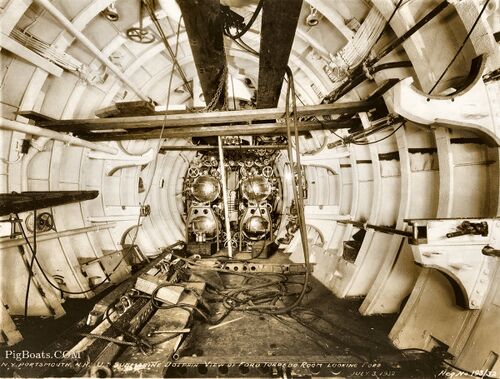
Dolphin's forward escape trunk can be seen above where the planks cross. The angled ladder leading to the trunk is seen leading into the trunk. In the upper left a large rod is seen. This is the mechanical linkage for the bow planes that runs back to the control wheel in the control room.
US Navy photo contributed by Tracy White
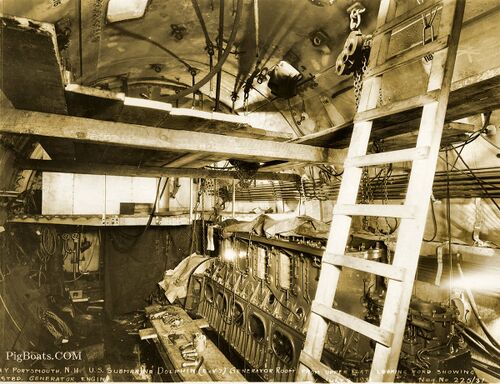
One more engine will be installed, and this will be lowered into the space via an opening in the hull above the wood ladder. Engineering spaces had what is called a "soft patch" in the hull that was bolted to the pressure hull to allow large pieces of equipment to be removed, repaired or replaced without needless cutting into the hull.
These engines were installed "backwards" in the space, with the generator attached to the crankshaft on the forward end of the engine; the generator itself is in the space underneath the storerooms and galley. The storerooms and galley are technically in the Generator Room and not the traditional position in the after battery. The amount of work left to complete in this space is considerable; compare this photo with similar photos on the interior photos page of the completed space.
US Navy photo contributed by Tracy White
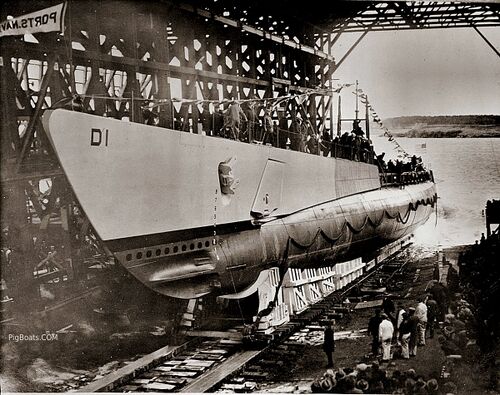
There are smatterings of Navy crew in amongst the shipyard worker riding the submarine down the ways. At the bow the Portsmouth Navy Yard Banner is flying. It reads backwards because the back of the banner is only seen by the camera. You may notice that in subsequent photos that there are anchors on both bows. This was later reduced to only one anchor per submarine.
There seems to be a distinct lack of bunting and ceremony involved in this launch. Perhaps due it being several years into the Great Depression and the government needed to show signs of austerity.
U.S. Navy photo
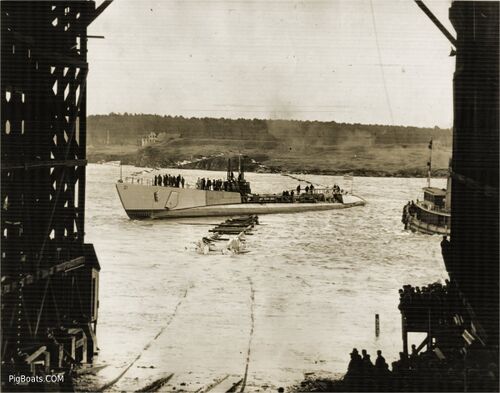
U.S. Navy photo in the private collection of Ric Hedman
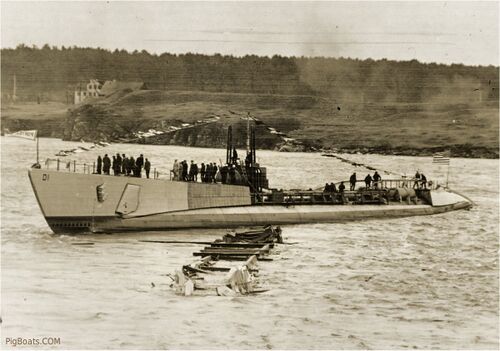
U.S. Navy photo in the private collection of Ric Hedman
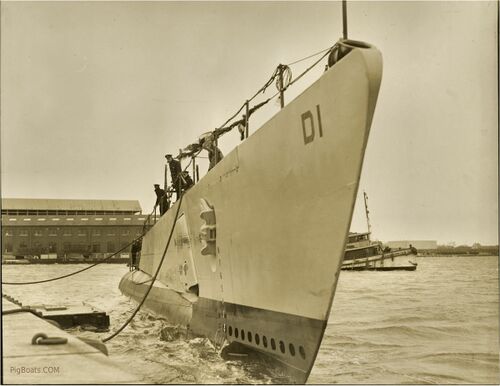
U.S. Navy photo
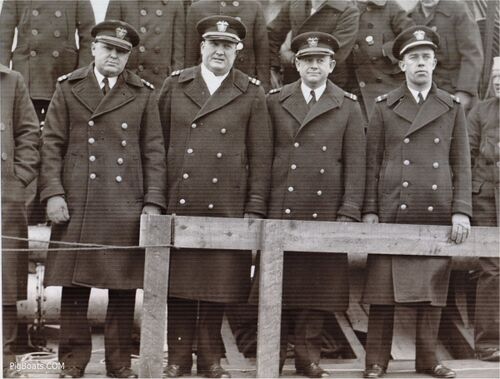
The officers seen here are from left to right: Executive Officer, LT Robert Eugene Blue; Commanding Officer, LT John B. Griggs Jr.; LTjg David E. Roth, and Ensign J. B. Johnson. The place the men are standing is sloped up to the right so that is why the photo looks strange. The cameraman "leveled" the picture to the deck.
U.S. Navy photo in the private collection of Ric Hedman
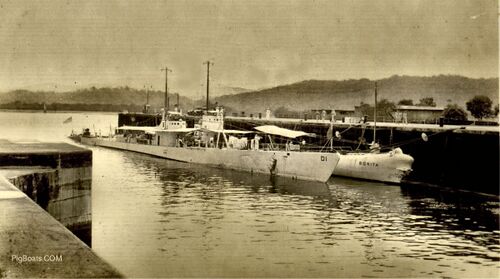
US Navy Photo Contributed by Roger Torgeson
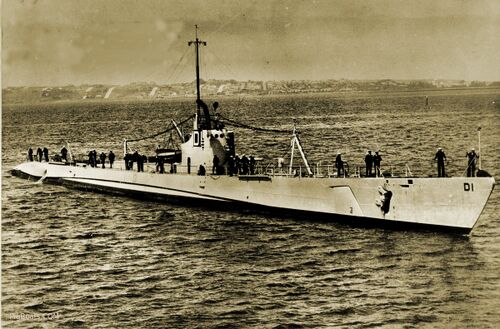
The sub has D-1 on her conning tower and bow. By March of 1939 that had been removed in favor of her hull number, plus she had been painted black as were most of the west coast submarines starting in 1934. She was used in the movie "Submarine D-1" in 1937 and had been painted black by that time.
Also, the crew are in Blue uniforms. These are worn from September 1 to May 31 in temperate climates. Hawaii is in the tropics and whites are worn all the time.
The submarine seems to be preparing to moor up to another vessel. The man all the way forward is getting ready to raise the Union Jack and the man all the way aft is ready to raise the American Flag. The underway colors are flying from the aft end of the conning tower fairwater. The man just left of the man at the bow is standing by with a heevie (a weighted line for tossing) to toss to the ship to haul the mooring lines across. Line handlers are standing by along the submarine's deck.
US Navy Photo Contributed by Roger Torgeson
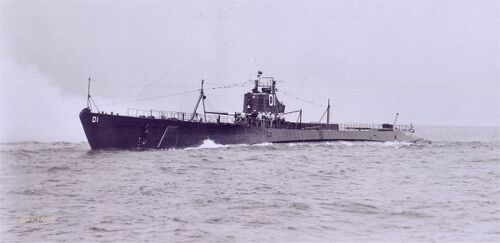
Just below the cluster of men manning the deck gun you can see the port side accommodation ladder.
News Photo Contributed by Roger Torgeson
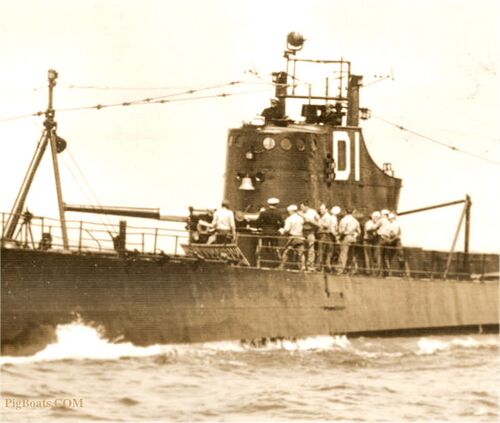
Photo in the private collection of Ric Hedman
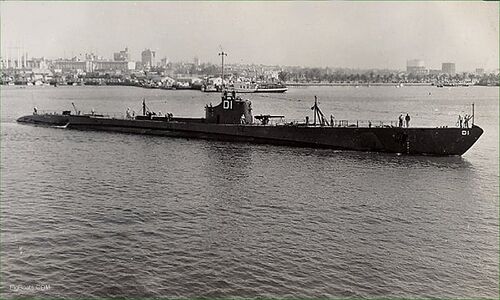
U.S. Navy photo
Page created by:
Ric Hedman & David Johnston
1999 - 2023 - PigBoats.COM©
Mountlake Terrace, WA, Norfolk, VA
webmaster at pigboats dot com
